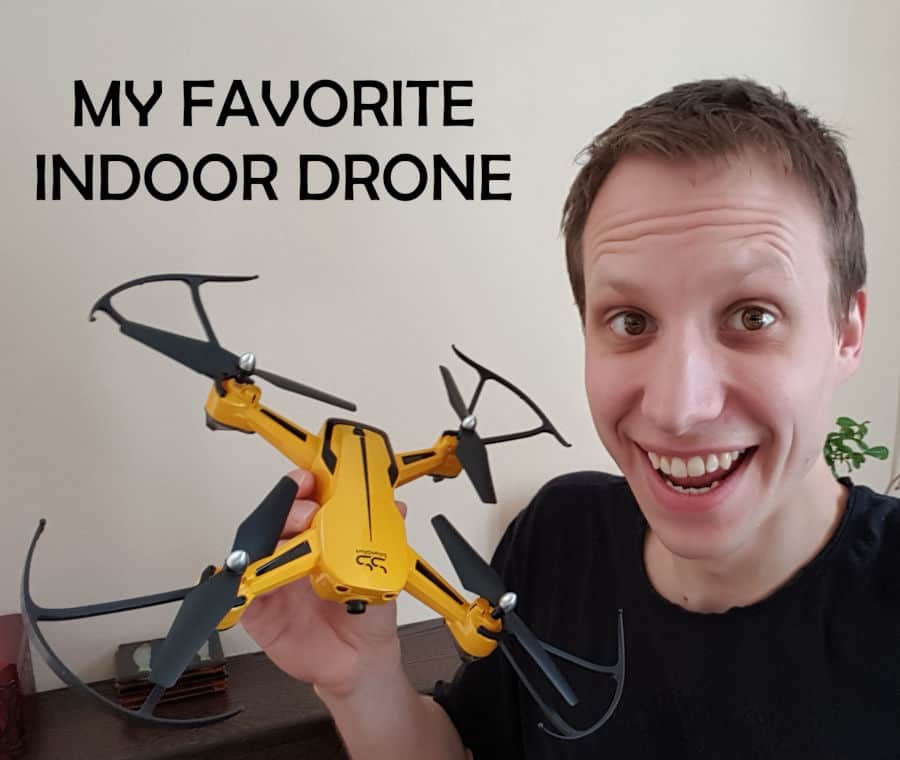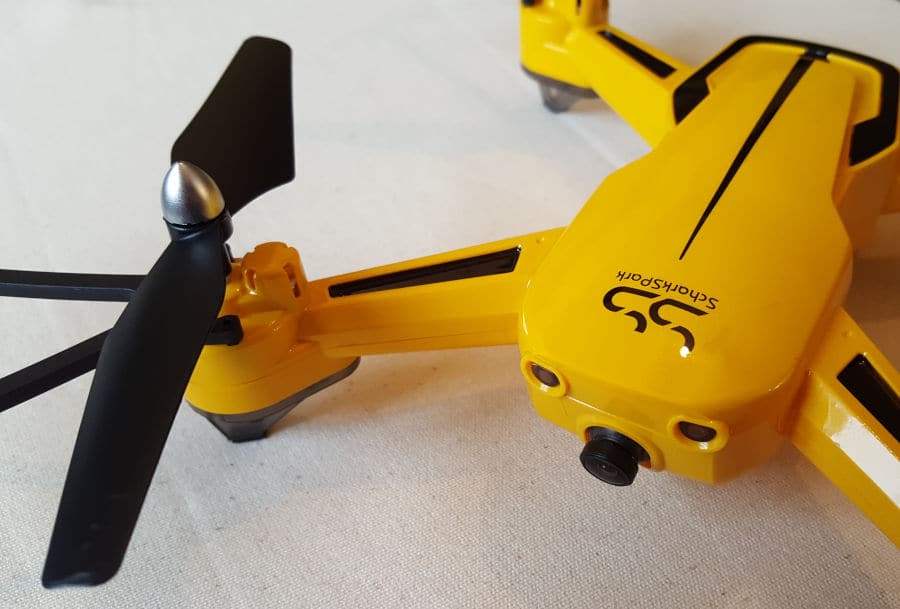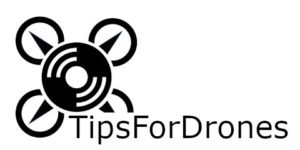
Flying a drone should not just be fun outdoors when the weather is nice. A real drone fan also flies indoors in their office or apartment. Even beginners want to make their first flight attempts with a small drone. Here I have a summary of what you have to consider when buying an indoor drone and what I would recommend to you.
After considering a lot of different drones, I decided to buy the ScharkSpark Drone SS40 (link to check the price on Amazon*) to fly in my apartment and little garden. For me, it’s the perfect balance of price, quality and functions. I was really surprised at the drone’s many practical features and I am very happy with it.
What do you want to do with the drone?
Generally, there are two main indoor drone applications. The first is the desk to desk flight, used mostly in the office. The second application is the indoor drone action. Depending on how you want to use the indoor drone, there are different things to consider. You get what you pay for, so you cannot expect too much from these little cheap drones.
My requirements for an indoor drone are that it has a camera for First-person view (FPV); can fly in little wind; and is agile in its flight behavior. The drone should also be controlled via your mobile phone and be very inexpensive. It should be able to survive a crash of 5 feet (1.5 meters), because this happens more often than you think.
Why do I recommend the ScharkSpark Drone SS40?
The ScharkSpark Drone SS40* has really good flight characteristics. It holds its exact position so that you can take your hands off the controller sticks. The movements during a fast flight are also very smooth and controllable, and I like the automatic take off/landing function.
The FPV Signal is easy to connect and has a good quality. To fly via the FPV Signal of the 120° wide lens you will need a little bit of training, but this kind of lens is important if you fly indoors.
Controlling with your mobile phone is very easy. What is really amazing is to control the drone via voice commands and I think the future will be to control the drone via phone tilting which is called “Gravity Sensing Flight Mode.” Thereby you tilt the mobile phone to the direction you want to fly. I like this mode.
The ScharkSpark SS40 is very quiet compared to other indoor drones and the propeller guard is built to be very sturdy. If you gently touch an object with the propeller guard, the drone will not crash like those just a few years ago; the SS40 holds its position and you can fly on without problems.
The flips can be made in whichever direction you want; just press the button “Flip” and choose one direction.
Specifications:
- Quadcopter Weight: 0.27 lbs (FAA Registration NOT Required)
- Drone Dimensions: 12.2 x 12.2 x 2.6 inches (34 x 21.6 x 7.6 cm)
- Video Recording Modes: 1280 x 1080p
- Charging time: about 60 mins
- Playing time: 10-12 mins
- Transmitter Operation Range: about 110 yards (100 m)
Features:
- 120° Wide Lens 1080p HD
- Large Gear Drive Motors
- G-Sensor Technology for control via mobile phone
- Voice Command
- Custom Waypoints
- 3D Flips
- Altitude Hold
- LEDs
- One Key Takeoff/Return/Land
- Three Speed Modes

What should you consider when buying a drone for an indoor fun application?
For a drone to be fun indoors, there are some things to consider. First, you should restrict the size of the drone. If you only have a small 500 sq. ft (45 m²) home, the drone should fit in one hand. In a larger apartment or house with a garden, it can also be a slightly larger drone (about two hands).
The next step is the use. Here you have to decide if the drone should have a camera for an FPV flight. The cameras on indoor drones now have really good resolutions between 720p HD and 1080p HD. I always find it really funny to fly the drone from one room to the next without having to go afterwards. That’s why my indoor drones all have a camera for a FPV flight.
The third point regarding the application is the possibility to fly flips. You press a button on the remote control or your mobile phone and then the drone does a somersault in the air.
Another important point is the control possibility. Many drones have their own transmitter. Indoor drones are not as stable as outdoor drones, so I think control sticks on a remote control are very helpful for exact flying. On the other hand, it is often very convenient when you do not need a remote control and can control the drone with your mobile phone. I would therefore recommend that you buy a drone that can be controlled with both a remote controller and a mobile phone.
Last but not least, the drone should fly stable even with low wind. This information can be found very quickly in the customer reviews of the drone or by watching videos of the drone on YouTube.
What should you consider when buying a drone for a desk to desk application?
When you buy a small desk to desk drone, it should not be more expensive than $30 and above all you should like the design. There are a lot of different technologies that all work well. Here is a list of various mini drones:
- Quadcopter
- Hexacopter
- Double Rotor Helicopter
- Helicopter
It is important that they can be quickly recharged via USB, so that the drone is ready for the next coffee break.
Why not start flying drones with a small indoor drone?
Small drones never fly as stably as larger ones. This is partly due to the size of the propellers. Small propellers have more turbulence related on their surface, which adversely affects the drone’s flight behavior.
The second reason is the flight controller. Larger drones are automatically stabilized via a GPS module from the flight controller. It keeps the drone exactly where you want it.
Thus, big drones are much more stable in the air. Beginners are especially stressed by controlling a small indoor drone.
For these reasons, I would recommend that beginners start with a large drone for the outside and then go with a smaller indoor drone.
What do you want to spend for an indoor drone?

I do not want to spend more than $100. Any drone that costs more should be well suited for flying outdoors, but then they are too big for an apartment. Small desk to desk drones should not cost more than $30.
The ScharkSpark Drone SS40 is in the midsection of the price for my requirements. The relationship between price, quality and features fits very well.
Flight modes for indoor drones
Automatic Takeoff/Landing:It´s a little bit creepy if you press a button and your drone starts automatically, but if you try it once, you will never take off or land again by yourself! 😉
Hold Altitude:The hold altitude mode is really comfortable if you fly indoors. This will allow you to be sure once you’ve set the right height, you can fly all over the home and this boosts the quality of your videos enormously.
Gravity Sensing Flight Mode:You can control your drone not only via touching your screen on your mobile phone, but also by tilting it. If you tilt your mobile phone forward, the drone will fly in that direction.
Flip:For acrobats, flip mode is a must. By pressing a button, the drone either makes a flip. You can also decide the direction of the flip on some drones.
Which additional parts do you need?
The only thing you will need are additional batteries. You can find them here. AMAZON LINK
Propeller Guards: Yes or No?
If you fly indoors, I recommend using propeller guards. If you are a beginner, the propeller guards will mostly protect the drone during the crashes. After some practice, you will begin to take more risks when flying, and then it is important to protect yourself and other people. Of course, propeller guards are not as safe as propeller cages, but they are better than nothing.
Conclusion
When choosing the right indoor drone, you should pay attention to your requirements. Do you want to fly from desk to desk? Do you want to fly FPV? Where do you want to fly? How much money do you want to spend?
You should ask yourself all of these questions before buying an indoor drone and I hope my article will help you with your answers.
*Affiliate Linke to Amazon
